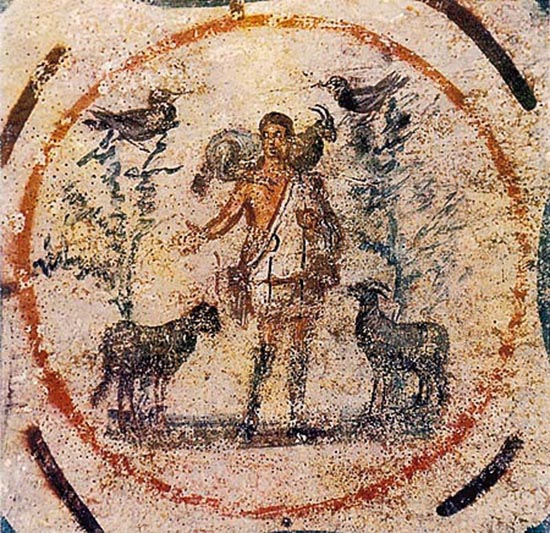Rome, the Eternal City, known for its surface splendours, reserves wonders even in its most hidden and underground sites. There are many findings of the early Christian period that can be visited today in the very heart of this city, which welcomed the first Christian communities. Those communities had given impetus to great artistic activity, flywheel to a message of salvation they wanted to convey at a still embryonic stage of the history of the Church.

The Catacombs of San Callisto, “Good shepherd”.
Among the most interesting catacombs is the complex of San Callisto, which is found along the Via Appia, and consists of a group of cemetery areas dated in the second century AD. The name of the Catacombs refers to a martyr Pope, very important in the history of the Western Church. Among the most significant areas of the complex are the so-called “Crypt of the Popes” and the “Crypt of St. Cecilia” with the “Cubicles of the Sacraments”, dating back to the early third century AD, with frescoes of the main sacraments of the liturgy, such as the Eucharist and the Baptism.
The Catacombs of Saint Sebastian, named after the Christian martyr who was buried there, are located in an area of Rome where once there were pozzolan quarries, along the via Appia Antica. This area was referred to as ad catacumbas, meaning “near the dip” (in Italian ‘avvallamento’), expression that later transformed into the modern term that referring to the catacombs. The Catacombs of St. Sebastian have many pagan and Christian tomb niches with decorative wall motifs and graffiti and invocations to the apostles Peter and Paul. We know that these burial grounds were intensely attended throughout the Middle Ages.

Catacombs of Priscilla, “Good shepard”.
In Via Salaria we find the Catacombs of Priscilla, named after the noble founder of the cemetery complex, whose contribution to its realization is evidenced by an inscription on the premises. Many Popes were buried in this cemetery, from Marcellino, to Silvestro, to Celestino and Vigilio. The decorations of the so-called “Cubicle of the Veiled” are directly related to the life of the deceased woman. The cubicle (small burial chamber by the side of the gallery) is decorated with paintings from the second half of the third century, which refer to matrimony, to motherhood and to the death of the person buried there. In one of the niches we find the oldest iconic evidence of the Madonna in the West, the Madonna and the Infant with the prophet Balaam, dating back to the third century. Another interesting area is the cryptoporticus (semi-subterranean porch) with the “Greek Chapel”, which was originally a private burial ground of a noble family, particularly important due to the presence of very old painting cycles, also from the third century.
The Catacombs of Saint Agnes are to be found in via Nomentana, which, due to a great flux of visitors, unlike the Catacombs of Saint Priscilla, are not very well preserved. The complex is dedicated to a very young Roman martyr, Agnese, of whose life there are several historical versions. Among these, the testimony of St. Ambrose and Prudentius, who recount that the girl was beheaded in the name of the Christian religion, and as a result of this incident, her cult spread very with great vigour. It seems that the Emperor Constantine was very devoted to this martyr, so much so that he ordered the construction in the vicinity of the area of a basilica and a domed mausoleum, beautifully decorated with mosaics and cupids, in honour of Constantina. It was only later that Pope Honorius built the basilica over Agnes’ grave, with an apse decorated with mosaics representing Agnes and the popes Honorius and Symmachus.
Near via Casilina rise the Catacombs of Saints Marcellinus and Peter, also called “Catacombs of St. Helena.” They extend over a very wide area of approximately 18,000 m². An excavation carried out in 2006 brought to light several areas that had never been discovered before, with frescoes and numerous bodies from the late second century AD, whose burial is probably linked to an outbreak of plague. The complex was reported by sources as “inter duas lauros” from the original name of the area. The development of this area dedicated to the Christian martyrs is related to Pope Damasus, who built the staircase leading to the burials, placed in an underground crypt. A large attendance of the area is attested, with frescoes and engravings in Latin and Runic.


